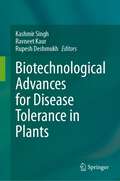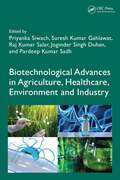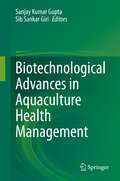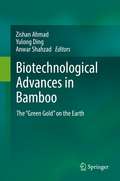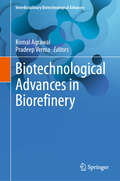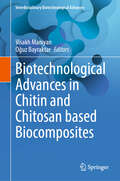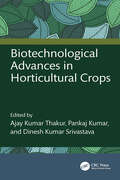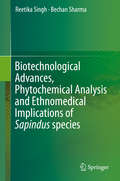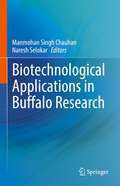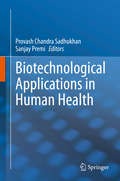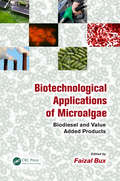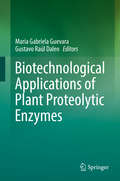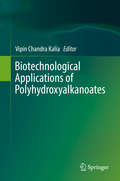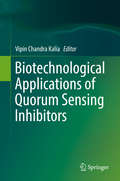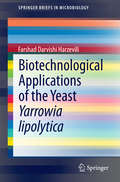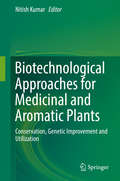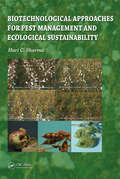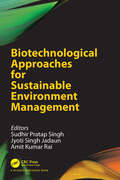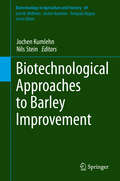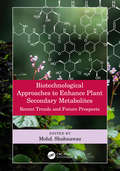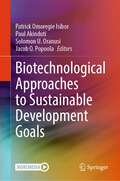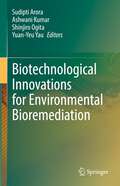- Table View
- List View
Biotechnological Advances for Disease Tolerance in Plants
by Rupesh Deshmukh Ravneet Kaur Kashmir SinghThis book covers the biotechnological advances being used for the understanding of plant diseases and the subsequent enhancement of disease resistance in crop plants. Chapters are focused on recent advances in sequencing technologies, computational resources and genomics tools useful for the identification of loci governing disease resistance. In addition, emphasis is given to novel approaches like genomic selection for achieving significant genetic gain for quantitative disease resistance. The book thoroughly describes sequencing-based approaches like whole genome sequencing, resequencing, and transcriptome profiling being explored for the understanding of disease resistance mechanisms. Finally, several chapters systematically describing the utilities and concerns of high-end technologies like genome-editing are provided. Simplified Illustrations are provided in every chapter to explain different biotechnological approaches and strategies. The book will help to better explore the biotechnological advances in development of disease resistant crop varieties.
Biotechnological Advances in Agriculture, Healthcare, Environment and Industry
by Suresh Kumar Gahlawat Raj Kumar Salar Priyanka Siwach Joginder Singh Duhan Pardeep Kumar SadhThere has been a surge in critical situations such as malnutrition, agricultural productivity, viral diseases, noncommunicable diseases, antibiotic resistance, and depletion of natural resourcest hreatening human welfare during the last decade. Fortunately, a parallel unprecedented growth and development have also taken place in various biotechnological sectors, giving hope and direction to meet these challenges.This book has been written with a very clear purpose of highlighting the contributions of modern biotechnology in solving emerging problems in various sectors. It has been divided into four major sections: Agricultural Biotechnology, Healthcare Biotechnology, Environmental Biotechnology, and Industrial Biotechnology. The chapters under each section are dedicated to the latest developments with comprehensive information about background, prospects, and applications. We have tried to incorporate the latest innovative biotechnological solutions such as biofortification, exome sequencing, genome sequencing, RNAi, drug discovery, nutrigenomics, bioremediation, nanobiotechnology and many more which have contributed remarkably in recent years to address the modern challenges in various sectors.The key highlights of this book are as follows:• Multidisciplinary perspective of biotechnological approaches.• Extensive investigation of hot topics. • Updated information with relevant data and statistics. • Application-based study of biotechnology.• Profusely illustrated and labeled diagrams to supplement the descriptions.This fully updated book will serve as a high-value resource book for students, teachers, researchers, and industry personnel in various disciplines of life sciences, agricultural sciences, medicine, environment, and industrial biotechnology. It will serve as a comprehensive resource book to develop an in-depth understanding of the emerging challenges in the areas of human welfare and analyze the latest biotechnological advancements in the direction of solving these concerns.
Biotechnological Advances in Aquaculture Health Management
by Sanjay Kumar Gupta Sib Sankar GiriThis book is an inclusive coverage of advances in aquaculture health management. It offers latest updates as well as explains the novel concepts and issues related to aquatic animal health management. To support the understanding of the concepts, there is extensive use of illustrations. Chapters emphasize on the state of art techniques and hold great promise for the sustainable development of aquaculture. This book is of interest to teachers, researchers, aquatic biologists, capacity builders and policymakers. Also the book serves as additional reading material for undergraduate and graduate students of aquatic sciences, marine sciences, biotechnology, ecology, and environmental sciences. National and international aquatic scientists, policy makers will also find this to be a useful read.
Biotechnological Advances in Bamboo: The “Green Gold” on the Earth
by Anwar Shahzad Zishan Ahmad Yulong Ding“Green gold” or “Poor Man’s Timber” are commonly used terms for bamboo that is a valuable and renewable resource of the world, and has always been an elemental part of human beings in terms of social and economic value. Bamboo is considered a multipurpose plant and has a prolonged history as an adaptable and extensively used renewable resource in conventional and commercial applications. Therefore, the annual demands for bamboos have already out-crossed the annual yields across the world. And the current scenario has forced scientists to pay more attention to the utilization of biotechnological tools for better understanding and improving bamboos. The book provides an overview of the different biotechnological approaches to advance bamboo research and better utilization of bamboo resources for human beings. Various applications of biological techniques in relation to bamboo have been discussed in details, for example, plant tissue culture techniques, somatic embryogenesis, germplasm conservation techniques, use of the molecular markers, transcriptomics, polymorphism, and phylogenetic relations in bamboo. It also addresses the novel industrial applications of bamboo in structural, food, and pharmaceuticals along with traditional uses. The aggregated information in this book demonstrates the way for the improved and sustainable practice of bamboos to fulfill the future needs of the world. This book is intended for use in both the industry and academia
Biotechnological Advances in Biorefinery (Interdisciplinary Biotechnological Advances)
by Pradeep Verma Komal AgrawalThis book is unique as it will cover the latest technological advancements in the field of biorefinery and how it is a major futuristic component of global biofuel research. Initially, the role of bio-based waste materials, microorganisms, and their bioactive metabolites in biorefinery will be focused. Further, recent advances and emerging topics that are related to industrially important products such as biofuels, hydrogen production will also be elaborated. The book addresses the lack of understanding of recent technological advancement such as life cycle assessment (LCA) and techno-economic assessment (TEA) as well. The systems for biorefineries demand a methodical approach to identifying effects and evaluating their long-term viability. Thus, a futuristic paradigm focusing on in silico studies, will also be incorporated, enabling us to understand the developments and impacts of bio-based materials towards a circular and sustainable economy. Additionally the proposed book will also discuss various strategies such as the analysis of cost-effectiveness, nanotechnology, value sensitive design (VSD) and also emphasize the economic, technical, and environmental aspects that affect their production as well as the future perspective in terms of the market scenario. Thus, the book will provide cumulative information on various dimensions of biorefinery and its role as a major bio-economic industry of the future for researchers, industrialists, entrepreneurs, career starters, and policymakers. The shift towards a bioeconomy not only promises innovative solutions to pressing global challenges but also opens up new avenues for various industries and policymakers. Thus, biorefinery is regarded as a crucial aspect of biobased economy ultimately leading the path towards sustainability.
Biotechnological Advances in Chitin and Chitosan based Biocomposites (Interdisciplinary Biotechnological Advances)
by Visakh Maniyan Oğuz BayraktarThis book presents a detailed examination of the recent biotechnological advances in chitin and chitosan-based biocomposites, highlighting their preparation, characterization, and wide-ranging applications. It offers a thorough exploration of how these biopolymers are revolutionizing fields such as tissue engineering, regenerative medicine, and drug delivery, with chapters dedicated to nanocomposites, chitin and chitosan whiskers, and their applications in food packaging, energy, and therapeutics. The chapters cover essential topics such as the biotechnological extraction of chitin from shrimp shells, the preparation and characterization of chitin and chitosan whiskers, and their integration into rubber, thermoplastic, and thermoset blends. The book also investigates the therapeutic potential of chitin and chitosan derivatives, focusing on their roles in drug delivery systems, wound healing, and antimicrobial applications. Additionally, it explores the use of these biopolymers in energy applications, including fuel cell technology and supercapacitor electrode materials. This comprehensive volume is designed for academics, researchers, and students in biochemistry, materials science, and biotechnology. It provides an in-depth understanding of the latest research and practical applications of chitin and chitosan, offering solutions to both fundamental and applied challenges. As a "one-stop" reference, it is an invaluable resource for those seeking to leverage the benefits of biodegradable and biocompatible composites in various scientific and industrial domains.
Biotechnological Advances in Horticultural Crops
by Pankaj Kumar Ajay Kumar Thakur Dinesh Kumar SrivastavaThe field of horticultural biotechnology has witnessed remarkable growth in recent years, offering profound insights and innovations that are reshaping agriculture's future. Biotechnological Advances in Horticultural Crops serves as a comprehensive guide to the latest innovations and applications. This meticulously curated volume bridges the gap between fundamental knowledge and cutting-edge advancements. From plant tissue culture to genomic approaches, this book spans a diverse array of topics, catering to a broad audience of students, researchers, and academics.Key Features: In-depth exploration of plant tissue culture and its applications in horticultural crop improvement. Insightful coverage of transgenic approaches in fruit crops, including genetic modifications for enhancing fruit quality, yield, and resistance to pests and diseases. Detailed examination of the application of omics sciences in tropical fruits, opening up new perspectives for crop improvement and sustainable production. Extensive discussion on the potential of in vitro production techniques for underutilized and unconventional horticultural crops. Exploration of sustainable agriculture practices, including the use of beneficial microbes and the scientific validation of natural and organic farming practices. This book is more than just a collection of topics; it’s a gateway to the transformative potential of biotechnology in horticulture. It empowers readers (students, researchers, and academicians) to comprehend and harness these advancements, promoting innovation and sustainability in horticultural crop improvement.
Biotechnological Advances, Phytochemical Analysis and Ethnomedical Implications of Sapindus species
by Reetika Singh Bechan SharmaPlants have always occupied a prominent position in the life of every living being. Plants are the primary source of food, shelter and medicines. The global inclination toward herbal medicine has advanced the expansion of plant-based pharmaceutical industries to a vast extent. The production of traditional medicine at global market has been estimated to touch US $5 trillion by 2050. Some of the useful plant-based drugs include vinblastine, vincristine, taxol, podophyllotoxin, camptothecin, digoxigenin, morphine, codeine, aspirin, atropine, capscicine, allicin, curcumin, artemesinin and ephedrine. Genus Sapindus is an important economical and medicinal trees, distributed over the world. Soap nuts contain higher amount of saponin, a natural detergent which can be used to clean clothes and hairs. Sapindus species possesses various pharmacological properties including antimicrobial, antioxidant, anti-inflammatory, anticancer, hepatoprotective, anti-trichomonas activity. Extracts of this plant are rich in various phytochemicals and polyphenolic compounds. All the pharmacological properties are due to presence of saponins. Biotechnological techniques can improve the saponin content; thus this chemical content can be produced at large scale and can be used as phytomedicine. We hope that this book would be of great use to under graduates, postgraduates, scientists, researchers and faculty members who are studying, teaching or working in the field of Biotechnology, Phytochemistry and Ethnopharmacology. The techniques explained in this book could be of immense use for the researchers working in this area. We shall deeply appreciate receiving any critical comments and suggestions from the readers from the different parts of globe which would help us improve the first edition of this publication.
Biotechnological Applications in Buffalo Research
by Manmohan Singh Chauhan Naresh SelokarThis book comprehensively reviews the advancements in biotechnological applications for the enhanced production and conservations of buffalo (Bubalus bubalis). The book discusses developments in assisted reproduction to improve productivity and the produce novel products for applications to human health and nutrition. The initial chapters of the book discuss the global distribution and domestications of buffalo, and nutritive values of buffalo milk, while the subsequent sections examine the applications of the genome-wide association traits to identify potential genetic variants affecting important economic traits. It identifies predictive biomarkers for postpartum or peripartum diseased-state and presents potential protein biomarkers for the diagnosis of early pregnancy in buffalo. Lastly, it discusses recent scientific developments such as induced pluripotent stem cells, spermatogonial stem cells, somatic cell nuclear transfer, and buffalo as a model for human biomedical research. This book is a useful source to students, academicians, researchers, and policymakers who are involved in buffalo science and industry.
Biotechnological Applications in Human Health
by Provash Chandra Sadhukhan Sanjay PremiThis book compiles selected articles presented at the International Conference on Biotechnology & Biological Sciences, BIOSPECTRUM 2017, organized by the Department of Biotechnology, University of Engineering & Management, Kolkata. Focusing on biotechnology-based analysis and intervention to address certain human diseases, the book includes a holistic discourse on disease profiling, molecular level analysis of diseases, and non-invasive medical interventions. It features articles on non-invasive treatment of iron deficiency anemia with iron nanoparticles; novel diagnosis methods based on microarray data; analysis using machine learning techniques like artificial neural network for early detection and treatment of cancer; and drug discovery for preventing the growth of human leukemic cells. Further, the book sheds light on in silico drug design using lipopeptides, and identifying the binding sites for their corresponding ligands. Presenting the concepts of the design of potent and safe antimicrobial compounds to fight multi drug resistant pathogens, it also includes interesting reviews on the design and development of various non-invasive methods, such as multi NIR wavelength probes to identify the risk areas in the diabetic foot at an early stage; and a low-cost cochlear implant prototype designed and developed from commercial off the-shelf components to empower the hearing impaired.The book appeals to students, academics and researchers in a wide range of subject areas, including biotechnology, life sciences, medicine and cancer research.
Biotechnological Applications in Industrial Waste Valorization (Interdisciplinary Biotechnological Advances)
by Vineet Kumar Pradeep VermaThis book overviews the cutting-edge applications of biotechnological tools and techniques in valorizing industrial waste to achieve the United Nations Sustainable Development Goals. It provides comprehensive insights into the latest research, technologies, processes, and case studies, making it an invaluable resource for researchers, professionals, policymakers, and students interested in waste management, bioenergy recovery, and sustainable development. By transforming industrial waste into high-value products, this book fosters a circular economy and lessens environmental strain, bridging the gap between academia and industry with practical solutions and innovative strategies. It seeks to fill the gap between academics and industry by outlining workable solutions and discussing cutting-edge tactics that can be used in realistic situations. While providing an in-depth exploration of advanced biotechnological techniques being widely used to valorize industrial waste, the book covers a wide range of issues that help academics and professionals efficiently deal with various waste streams, such as microbial bioremediation, renewable energy, resource recovery, enzymatic degradation, metabolic engineering, bioprocess development, and others. The book intends to motivate and guide students, researchers, practitioners, and policymakers in pursuing sustainable waste management strategies by exhibiting the revolutionary power of microbial technology. The concise and impartial content structure will also benefit corporate researchers. It is an essential resource for anyone interested in the intersection of biotechnology and environmental sustainability, offering insights that are both academically rigorous and practically applicable.
Biotechnological Applications of Biodiversity (Advances in Biochemical Engineering/Biotechnology #147)
by Joydeep MukherjeeThis book review series presents current trends in modern biotechnology. The aim is to cover all aspects of this interdisciplinary technology where knowledge, methods and expertise are required from chemistry, biochemistry, microbiology, genetics, chemical engineering and computer science. Volumes are organized topically and provide a comprehensive discussion of developments in the respective field over the past 3-5 years. The series also discusses new discoveries and applications. Special volumes are dedicated to selected topics which focus on new biotechnological products and new processes for their synthesis and purification. In general, special volumes are edited by well-known guest editors. The series editor and publisher will however always be pleased to receive suggestions and supplementary information. Manuscripts are accepted in English.
Biotechnological Applications of Microalgae: Biodiesel and Value-Added Products
by Faizal BuxMicroalgae are an invaluable biomass source with potential uses that could lead to environmental and economic benefits for society. Biotechnological Applications of Microalgae: Biodiesel and Value Added Products presents the latest developments and recent research trends with a focus on potential biotechnologically related uses of microalgae. It gi
Biotechnological Applications of Plant Proteolytic Enzymes
by María Gabriela Guevara Gustavo Raúl DaleoThis book offers an overview of the diverse fields application of proteases (also termed proteolytic enzymes or proteinases), including food science and technology, pharmaceutical industries, and detergent manufacturing, reviewing the advances in the biotechnological application plant proteolytic enzymes over the last decade. In recent years, they have been the focus of renewed attention from the pharmaceutical and biotechnology industries, not only because of their activity on a wide variety of proteins but also because they are active over a range of temperatures and pHs. The main audience of this book are researchers working with plant proteases but also professionals from several industry segments such as food production and pharmaceutical companies.
Biotechnological Applications of Polyhydroxyalkanoates
by Vipin Chandra KaliaThis book presents the latest research on the uses of polyhydroxyalkanoates (PHA), introducing readers to these natural, biodegradable polyesters produced by microorganisms, their functions and applications. The individual chapters discuss the various potentials of these bioplastics, which offer an attractive alternative to non-biodegradable plastics. The book also describes the diverse medical and biomedical applications of PHAs, including their use as drug carriers, memory enhancers, and biocontrol agents, and examines their role in creating a more sustainable economy – which is the need of the hour.
Biotechnological Applications of Quorum Sensing Inhibitors
by Vipin Chandra KaliaThis book discusses the practical applications of quorum sensing inhibitors for both human and plant health. Quorum sensing inhibitors that disrupt microbial biofilms can be employed to treat bacterial infections. The book describes the various bioactive molecules that can serve as quorum sensing inhibitors to combat deadly bacterial infections, in addition to several synthetic quorum sensing inhibitors. Quorum sensing is the mechanism through which bacteria develop antibiotic resistance. Intended to provide a clearer understanding of the practical applications of quorum sensing inhibitors, the book details how the problem of antibiotic resistance can be countered through the intelligent application of quorum sensing inhibitors.
Biotechnological Applications of the Yeast Yarrowia lipolytica (SpringerBriefs in Microbiology)
by Farshad Darvishi HarzeviliDue to its ability to degrade hydrophobic substrates highly efficiently, the non-conventional yeast Yarrowia lipolytica offers various applications in the food, feed, pharmaceutical, and fine chemistry industries, as well as in environmental protection contexts such as waste treatment and bioremediation. The yeast breaks down hydrophobic substrates such as n-alkanes, fatty acids, fats, and oils, yielding valuable biotechnological products such as organic acids, extracellular enzymes, aroma compounds, bioemulsifiers, polyols, single-cell proteins, and single-cell oils. Further, Y. lipolytica is an efficient platform for the production of various heterologous proteins; more than a hundred heterologous proteins - including those of viruses, bacteria and fungi, as well as plant, animal and human proteins - have already been produced in Y. lipolytica. Since its genome has been sequenced, it is now possible to use new recombinant technology and metabolic engineering in order to improve the metabolic pathways involved in the creation of desirable metabolites and products.
Biotechnological Approaches for Medicinal and Aromatic Plants: Conservation, Genetic Improvement and Utilization
by Nitish KumarFor the majority of the world’s population, medicinal and aromatic plants are the most important source of life-saving drugs. Biotechnological tools represent important resources for selecting, multiplying and conserving the critical genotypes of medicinal plants. In this regard, in-vitro regeneration holds tremendous potential for the production of high-quality plant-based medicines, while cryopreservation – a long-term conservation method using liquid nitrogen – provides an opportunity to conserve endangered medicinal and aromatic plants. In-vitro production of secondary metabolites in plant cell suspension cultures has been reported for various medicinal plants, and bioreactors represent a key step toward the commercial production of secondary metabolites by means of plant biotechnology. Addressing these key aspects, the book contains 29 chapters, divided into three sections. Section 1: In-vitro production of secondary metabolites Section 2: In-vitro propagation, genetic transformation and germplasm conservation Section 3: Conventional and molecular approaches
Biotechnological Approaches for Pest Management and Ecological Sustainability
by Hari C SharmaDue to increasing problems occurring from massive applications of pesticides, such as insect resistance to pesticides, the use of biotechnological tools to minimize losses from insect pests has become inevitable. Presenting alternative strategies for alleviating biotic stresses, Biotechnological Approaches for Pest Management and Ecological Sustain
Biotechnological Approaches for Sustainable Environment Management
by Amit Kumar Rai Sudhir Pratap Singh Jyoti Singh JadaunBiotechnological advancements offer approaches for sustainable environmental management, owing to their capacity to tackle various environmental issues, including pollution, waste management, and resource conservation. The state of the environment is continually deteriorating due to industrialization and different human actions. Innovations must be pursued to mitigate the detrimental impact of environmental pollutants. The ubiquitous presence of microbial resources offers vast potential for developing technologies aimed at reducing the levels of harmful substances contaminating the environment. This book is focused on biotechnological applications designed to address environmental challenges associated with industrial effluents, plastic and biological wastes. The chapters in the book emphasize the microbial agents that are helpful in managing industrial and agricultural wastes.
Biotechnological Approaches for Sustaining Forest Trees and Their Products
by Ajay Kumar M. K. Razdan Dennis Thomas TThis edited book gives an in-depth coverage of various aspects of biotechnological procedures followed by international scientists and researchers to sustain growth and improvement of forests in context of current climatic change. Forests especially trees play a crucial role in maintaining the ecological balance as well as in the functioning of natural ecosystem. More importantly, they contribute to the economic growth of a country through its products such as timber, fuel, pharmaceuticals, fibre for textile industry and edible fruits. The denudation of trees due to urbanisation of towns/cities/villages by various construction activities and industrialisation directly impact the climate change resulting in global warming, short rainfall or erroneous weather currently experienced. This book is an effort to address these problems and attempts to find out solutions using biotechnological approaches. Most of the proposed chapters cover latest information. The proposed book deals with biotechnological aspects of forest trees such as micropropagation, somatic embryogenesis, somaclonal variation, synthetic seeds, cryopreservation, disease amangement and genetic engineering. Further, applications and limitations of these approaches to improve the forest trees are discussed. The book is of relevance to teachers, students and researchers working in area of forest and plant biotechnology globally.
Biotechnological Approaches to Barley Improvement (Biotechnology in Agriculture and Forestry #69)
by Jochen Kumlehn Nils SteinThis volume offers an up-to-date overview of biotechnologically oriented barley research. It is structured into two major sections: the first focusing on current agricultural challenges and approaches to barley improvement, and the second providing insights into recent advances in methodology. Leading scientists highlight topics such as: the global importance of barley; genetic diversity and genebanks; domestication; shoot and inflorescence architecture; reproductive development; mineral nutrition; photosynthesis and leaf senescence; grain development; drought tolerance; viral and fungal pathogens; phytophagous arthropods; molecular farming; sequence resources; induced genetic variation and TILLING; meiotic recombination; Hordeum bulbosum; genome-wide association scans; genomic selection; haploid technology; genetic engineering; and whole plant phenomics. Providing comprehensive information on topics ranging from fundamental aspects to specific applications, this book offers a useful resource for scientists, plant breeders, teachers and advanced students in the fields of molecular and plant cell biology, plant biotechnology, and agronomy.
Biotechnological Approaches to Enhance Plant Secondary Metabolites: Recent Trends and Future Prospects
by Mohd. ShahnawazThousands of secondary metabolites are produced by plants to withstand unfavourable environmental conditions and are important molecules for nutraceutical, agro, cosmetic and pharmaceutical industries, etc. Harvesting of plants for the extraction of these important metabolites can threaten the plant germplasm, and various medicinally important plants are at the verge of extinction. Based on need, various methods and strategies were developed and followed by researchers from time to time to save the plant germplasm and produce important secondary metabolites efficiently to meet their growing demands. Biotechnological Approaches to Enhance Plant Secondary Metabolites: Recent Trends and Future Prospects provides a comprehensive introduction and review of state-of-the-art biotechnological tools in this field of research at global level. The methodologies are highlighted by real data examples in both in vitro and in vivo level studies. The book: • Highlights and provides overviews of the synthesis, classification, biological function and medicinal applications of the recent advancements for the enhanced production of novel secondary metabolites in plants • Provides an overview of the role of induced mutation, salinity stress and brassinosteroids impact to increase the secondary metabolic contents in plants and suggests an increase in enzymatic activity in plants could be due to various point mutations, which in turn could play a role at transcriptome levels • Discusses the significant role of endophytes to enhance the contents of plant secondary metabolites • Alternatively, suggests the urgent need to set up the standard operating procedures using hydroponics system of cultivation for significant enhancement of secondary metabolite contents • Enlists various in vitro techniques to enhance plant secondary metabolites contents using plant tissue culture approaches • Provides a systematic overview of state-of-the-art biotechnological tools CRISPER Cas9 and RNAi to enhance the plant secondary metabolite contents • Recommends CRISPER Cas9 technology over RNAi, ZFNs and TALENs because of its relatively simple and high precision method with an easily programmable tool This serves as a reference book for the researchers working in the field of plant secondary metabolites and pharmaceutical industries at global level.
Biotechnological Approaches to Sustainable Development Goals
by Solomon U. Oranusi Patrick Omoregie Isibor Paul Akinduti Jacob O. PopoolaBiotechnological Approaches to Sustainable Development Goals presents selected contributions from the 2022 International Biotechnology Conference Exhibition and Workshop (IBCEW) that cover techniques, current trends, and cutting-edge biotechnological tools for achieving sustainable development goals (SDGs). The authors explore recent advances that solve challenges related to sustainable agriculture, climate change, prevention and control of pandemics, biotechnology for a sustainable economy, and biotechnological industries and SDGs. The IBCEW aims to share knowledge, experiences, and ideas among scientists, academics, students, industry representatives, and other professionals interested in biotechnology and attaining SDGs for development in Nigeria, Africa, and globally.
Biotechnological Innovations for Environmental Bioremediation
by Ashwani Kumar Shinjiro Ogita Yuan-Yeu Yau Sudipti AroraThis edited book focuses on the application and implementation of bioremediation and other strategies to create a sustainable and healthy environment. It provides a collection of approaches to environmental biotechnology for wastewater treatment, removal of soil heavy metals, degradation of pesticides, removal of dyes, waste management, and microbial conversion of environmental pollutants. This book brings to the fore contributions of certain globally important environmental biotechnologist. Bioremediation is a popular branch of biotechnology that involves the use of living organisms such as microorganisms (microbial remediation), bacteria, fungus (mycoremediation), and plants (phytoremediation) to bind, extract, and clean up contaminants, pollutants, and toxins from soil, groundwater, and other environments. This book is of interest to researchers, scientists, and academic faculty in environmental sciences. Also, it serves as additional reading and reference material for undergraduate and graduate students as well as postdocs in environmental, agriculture, ecology, and soil sciences. National and International policy makers will also find valuable information from this book.
